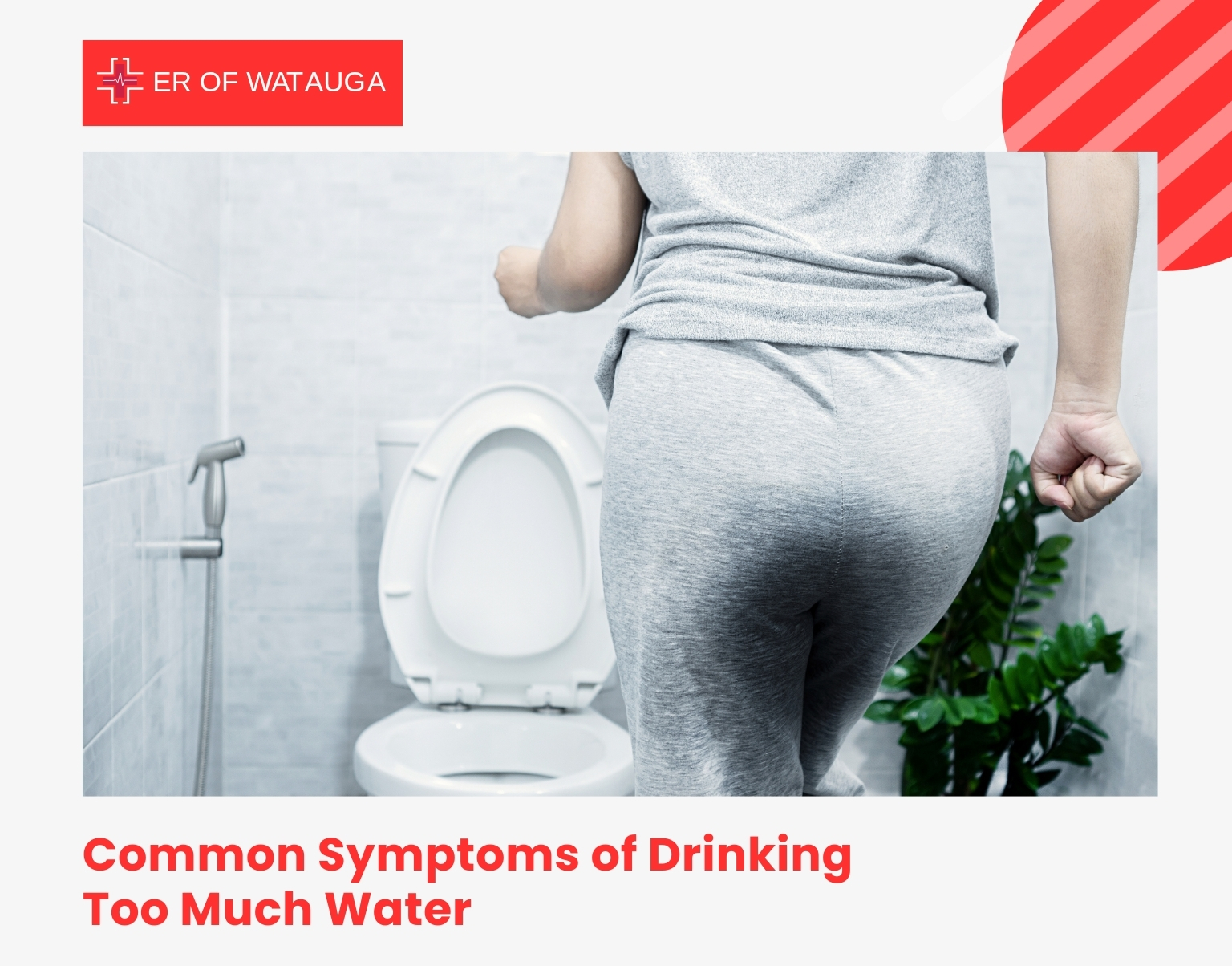Water is essential for our bodies; it helps with digestion, keeps our skin healthy, and regulates temperature. But did you know that drinking too much water can be harmful? This condition, called overhydration or water intoxication, can lead to a serious issue known as hyponatremia, where sodium levels in your blood drop too low.
While it’s rare for most people, it can happen to athletes, those with certain health conditions, or anyone who overdoes it. In this blog, we’ll break down the Symptoms of Drinking Too Much Water.
What is Overhydration and Hyponatremia?
Overhydration occurs when you consume more water than your kidneys can eliminate. Your kidneys can handle about 0.8 to 1 liter (around 27 to 34 ounces) of water per hour in healthy adults. When you drink beyond that, especially quickly, it dilutes the sodium in your blood.
Sodium is an electrolyte that helps balance fluids in your body. Low sodium (below 135 mEq/L) causes hyponatremia, leading to cell swelling, especially in the brain, which can be dangerous. Other names for water intoxication include:
- Water poisoning
- Water toxicity
- Hyperhydration
- Overhydration
- Water toxemia
- Dilutional hyponatremia
- Water-electrolyte imbalance
Common Symptoms of Drinking Too Much Water
Symptoms start mild but can get severe if not addressed. They often mimic dehydration, like headaches or nausea, so it’s easy to confuse them. Here’s a simple table of symptoms, divided by severity:
Severity Level |
Symptoms |
Description |
| Mild | Clear or colorless urine | Your pee looks like water, meaning you’re over-diluting your body. |
| Mild | Frequent urination (more than 8-10 times a day) | You keep running to the bathroom because your body can’t hold the excess. |
| Mild | Swelling in hands, feet, or lips | Fluid buildup causes puffiness or discoloration. |
| Moderate | Nausea, vomiting, or diarrhea | Excess water upsets your stomach as kidneys struggle. |
| Moderate | Headache or throbbing pain | Brain cells swell, pressing against the skull. |
| Moderate | Fatigue, weakness, or muscle cramps | Low sodium affects muscle function and energy levels. |
| Severe | Confusion, disorientation, or brain fog | Swollen brain cells disrupt thinking and balance. |
| Severe | Seizures or trouble breathing | In extreme cases, this can lead to coma or death if untreated. |
If symptoms worsen quickly, like seizures or coma, it can be life-threatening. Always seek help right away.
Causes and Risk Factors
The main cause is drinking more water than your body can process. For example, endurance athletes might chug water during long events, overwhelming their kidneys. Other causes include:
- Certain medications can cause you to feel thirsty or retain water.
- Health issues like kidney, heart, or liver problems that slow water excretion.
- Conditions like SIADH (Syndrome of Inappropriate Anti-Diuretic Hormone), where your body holds onto too much water.
- Psychiatric disorders causing compulsive drinking (psychogenic polydipsia).
- Forced overdrinking, rarely seen in child abuse cases.
Risk factors include:
- Being an endurance athlete (e.g., marathons, triathlons).
- Older adults or those with low body mass, like children.
- People in hot environments sweat heavily.
- Those with schizophrenia or other mental health issues.
How Much Water is Too Much?
There’s no one-size-fits-all rule, but healthy adults need about 9-13 cups (78-100 ounces) of fluids daily, including from food. Factors like exercise, heat, pregnancy, or illness increase needs. However, exceeding 1 liter per hour can risk overhydration.
Here’s a quick table for daily water guidelines (adjust based on your needs):
Group |
Recommended Daily Fluids |
Notes |
| Adult Men | About 13 cups (3 liters) | Includes all fluids, not just water. |
| Adult Women | About 9 cups (2.2 liters) | More if pregnant or active. |
| Athletes During Exercise | Drink to thirst; replace sweat loss | Use sports drinks for events over 1 hour. |
| Children | Varies by age; consult a doctor | Smaller bodies mean lower limits. |
Prevention Tips
Staying hydrated is key, but balance is everything. Here are easy tips:
- Drink when thirsty, don’t force it.
- Check urine color, aim for pale yellow.
- For long workouts, sip sports drinks with electrolytes instead of plain water.
- If you have health conditions or take meds, talk to your doctor about fluid limits.
- In hot weather or during intense activity, replace what you sweat out, not more.
- Limit to 800-1,000 mL (about 27-34 ounces) per hour max.
When to See a Doctor?
If you notice mild symptoms like constant clear urine or headaches after heavy drinking, cut back on water and monitor. But get emergency care for severe signs like confusion, seizures, or vomiting that won’t stop. Doctors may test blood sodium and suggest treatments like fluid restriction, IV electrolytes, or meds to increase urine output.
FAQs
1. What are the main symptoms of drinking too much water?
Drinking too much water can lead to hyponatremia, where your blood’s sodium levels drop too low. Symptoms start mild and can get serious. Common ones include:
- Clear or colorless urine (your pee looks like water).
- Frequent urination.
- Swelling in hands, feet, or lips.
- Nausea, vomiting, or diarrhea.
- Headache or throbbing pain.
- Fatigue, weakness, or muscle cramps.
- Confusion, disorientation, or brain fog.
- In severe cases, seizures, trouble breathing, or even coma.
2. How much water is considered too much?
It depends on your body, activity level, and health, but healthy adults can usually handle up to 1 liter (about 34 ounces) of water per hour. Daily guidelines suggest about 3.7 liters (15.5 cups) for men and 2.7 liters (11.5 cups) for women, including fluids from food.
3. What causes overhydration?
Overhydration happens when you take in more water than your kidneys can remove, or if your body holds onto too much fluid.
4. Is drinking too much water dangerous?
Yes, in rare cases, it can be life-threatening. Severe overhydration causes hyponatremia, leading to brain swelling, seizures, or coma.
5. How can I prevent overhydration?
Listen to your body:
- Drink when thirsty, and aim for pale yellow urine as a guide.
- During exercise, sip fluids with electrolytes like sports drinks, especially for sessions over an hour.
- Don’t exceed 800-1,000 mL (27-34 ounces) per hour.
- If you have medical conditions, ask your doctor about safe fluid limits.
- Weigh yourself before and after workouts; weight gain means you’re overhydrating.
6. What is hyponatremia?
Hyponatremia is a condition where sodium in your blood falls below normal levels (under 135 mEq/L), often from too much water diluting it. It causes cells to swell and can affect brain function.
7. When should I see a doctor for overhydration symptoms?
See a doctor if you have mild symptoms like persistent headaches, nausea, or swelling after drinking a lot of water. Get emergency help for severe signs like confusion, seizures, vomiting that won’t stop, or trouble breathing.
8. How common is overhydration?
It’s rare for most people because our bodies regulate thirst well. But it’s more common in endurance athletes, older adults, or those with certain health conditions.
9. How does overhydration affect the body?
Excess water lowers sodium, causing an electrolyte imbalance. This makes cells absorb too much water and swell, especially in the brain, leading to pressure and symptoms like headaches or confusion.
10. What are the treatments for overhydration?
Treatment depends on severity. For mild cases, stop drinking water and eat salty foods to restore sodium. Severe cases may need hospital care with IV fluids, medications to increase urine output, or monitoring sodium levels.









